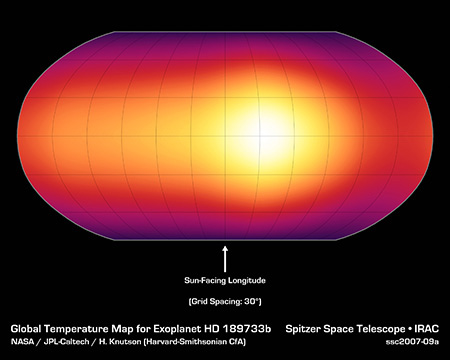Mapping an Alien World

JonathanFortney, a planetary scientist and Astrobiologist from the Carl Sagan Center may well have something in common with Claudius Ptolemy. They are bothpioneers in the world of map making, despite lacking more data than theyactually possess. Ptolemy, working a couple of millennia ago, created some ofthe earliest known maps of planet earth based on rudimentary knowledge of lessthan one quarter of the globe. Jonathan and his team have modeled a rudimentarytemperature map of an alien world, the first of its kind, with an even morelimited data set. Still, this new map represents our first real insight into anextra-solar planet, any extra-solar planet, beyond knowing that it exists ordoesn't. The map is pictured here (Figure 1).
The search forextra-solar planets, those around stars outside our solar system, has beenstepping up over the last decade or so. Since the discovery of 51Pegasi (Figure 2), announced in late 1995, roughly 216 giant extra solarplanets have been detected orbiting their parent stars scattered throughout theMilky Way. To date, these alien worlds are Jupiter-like gas giants, notnecessarily because giants abound out there, but because, like the guy lookingfor his lost keys under the lamppost, with current detection methods, giantsare what we are able to find.
Dr. Fortneyspecializes in "hotJupiters". These are giant gas planets much like our Jupiter butorbiting very close to their parent stars and whizzing around them in days,rather than the years (11.9 for Jupiter and 29.5 for Saturn, 84 for Uranus, and165 for Neptune) that it takes our own. Their orbits are small and their speedsrapid because they are so close in to their stars. This proximity and thegravitational wobble that closeness causes to their parent stars, is often whathelps us detects these planets. The closeness also accounts for the heat. Inaddition, such "hot Jupiters" are inevitably tidally locked to theirparents. That is, their orbital periods are identical to their rotations, and theyalways present a single face to their parent stars, much as our moon alwaysfaces the earth. This happens for known reasons due to the unstable distortingtug of gravity of the larger body on the smaller, close in body. Thisinstability is resolved through tidal locking.
Planet HD189733b was detected by NASA's SpitzerSpace Telescope, an infrared space based observatory looking at heat energyin the universe (Figure 3). Looking from space, Spitzer was able to use analternative detection method to discover this new planet. The method is calledtransit photometry. As a planet circles its parent star it crosses in front ofthat star, reducing the total luminosity, or light output, slightly. In effect,the planet eclipses the star. If you continue to observe such a system, thereduced luminosity will be repeated, and you learn the orbital period of theorbiting body. Spitzer has discovered 3 new planets using this detection methodwithout having been specifically designed to do so. In 2008, NASA's KeplerMission, specifically designed and dedicated to detecting planets throughtransit photometry, will launch and gaze at 100, 000 stars. Kepler'ssensitivity is such that it will be capable of detecting small, inner, rockyplanets like earth in addition to gas giants.
Jonathanand his team successfully competed to get 33 continuous hours of observing timeout of Sptizer's precious schedule to get the data set that became thetemperature map, the first true map of any extra solar planet. HD 189733b is 63light years away and orbits its parent star in 50 hours. Previous models andtemperature data of gas giant planets seemed to suggest that such bodies wouldbe very hot on their sun facing sides and significantly cooler on their farsides. What Forney and his team found was a smaller temperature range thanmight have been predicted plus an intriguing displacement of the "hotspot". What accounts for their results is almost certainly the presence ofhigh winds, some kilometers per second that transport the energy to the far sideof the planet. The team is continuing to refine their model to understand thesewinds and the transport mechanisms involved.
HotJupiters are interesting for several reasons. They are extremely luminous whenthey are formed, 1000 time more luminous than the 4.5 billion year old planetsin our solar system. We may someday be able to directly image such planets fromspace. We don't truly understand their formation and evolution and atmospheresyet. We know gas giants are largely composed of hydrogen and helium, the mostabundant elements in the universe. In our solar system gas giants form farenough from the sun that these volatile elements don't just burn off. What is happening with these newly detected close in giants? Saturn displays "excess" luminosity and appearsto be powered by an additional interior energy source that Jupiter may nothave. We don't understand this yet, but the Cassini Mission, stillorbiting Saturn continues to provide insight. Understanding the formation,evolution and atmospheres of gas giants will help us understand the structureand evolution of solar systems in general and will eventually give us insightinto how rocky planets form and evolve. Rocky planets, like earth, are capableof holding liquid water and could support life. Now, that's really interesting.
- Top 10 Most Intriguing Extrasolar Planets
- Stars May Be Eating 'Hot Jupiters'
- Planets Found in Potentially Habitable Setup
Get the Space.com Newsletter
Breaking space news, the latest updates on rocket launches, skywatching events and more!
Join our Space Forums to keep talking space on the latest missions, night sky and more! And if you have a news tip, correction or comment, let us know at: community@space.com.









